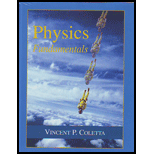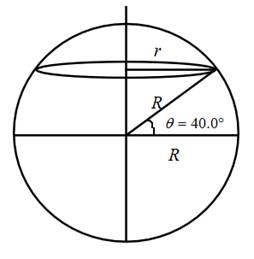
Concept explainers
The velocity of a rocket launched at
Answer to Problem 42P
The velocity of a rocket launched at
Explanation of Solution
Given info:
The latitude of the point of launch,
Velocity of the rocket with respect to the center of the Earth,
Formula used:
The velocity of the ground with respect to the ground
Here, r is the radius of the circular path traversed by the particle and T is the time taken for it to complete one rotation.
Calculation:
The point of launch is at a latitude
This is shown in the diagram below:

From the diagram, it can be seen that,
Here, R is the radius of the Earth, which has a value
Express the radius of the Earth in meters.
Calculate the value of r by substituting the values of R and
The Earth takes 24 h to complete one rotation. In the same time, the point on the ground completes its circular path of radius r .
Calculate the time T taken by the point on the ground to go once around the circular path of radius r in seconds.
Substitute the values of r and T in equation (1) and calculate the magnitude of the ground’s velocity relative to the center of the Earth.
The Earth rotates from west towards east. Hence, the point where the rocket is launched has a velocity
The rocket is launched with a speed of 11.0 km/s eastward with respect to the center of Earth.
Express the speed
The Ground rotates with a speed
The speed
Calculate the speed
If the rocket is launched at a point near the equator, the ground moves in a circular path equal to the radius of the Earth. Calculate the speed of the ground at the equator using equation (1) in the following form:
Substitute the given values in the above expression and calculate the velocity of the ground with respect to the center of Earth at equator.
The speed that needs to be imparted to the rocket at equator is the relative velocity of the rocket with respect to the ground.
The difference in the velocities of the rocket when launched at 40.0o latitude and at equator is given by,
Substitute the given values in the above expression:
Conclusion:
Thus, the velocity of a rocket launched at 40.0oNorth latitude along East, with respect to the ground is found to be
Want to see more full solutions like this?
Chapter 3 Solutions
Physics Fundamentals
- Olympus Mons on Mars is the largest volcano in the solar system, at a height of 25 km and with a radius of 312 km. If you are standing on the summit, with what Initial velocity would you have to fire a projectile from a cannon horizontally to clear the volcano and land on the surface of Mars? Note that Mars has an acceleration of gravity of 3.7m/s2 .arrow_forwardA projectile is launched with an initial velocity of v0 and an elevation angle of zero degrees. If the projectile were launched with the same initial velocity from the surface of Earth (g=9.80 m/s2) as from the surface of Mars (g=3.72 m/s2), which of the following would be true? a. Both the time of flight and the range would be larger on Mars. b. Both the time of flight and the range would be larger on Earth. c. The time of flight is greater on Earth but the range would be greater on Mars. d. The time of flight is greater on Mars but the range would be greater on Earth. e. The time of flight and the range would be the same on both planets.arrow_forwardA vessel sets out from Delfzijl, The Netherlands, heading due north at 9.5 m/s relative to the water. The local ocean current is 1.50 m/s in a direction 40.0° north of east. What is the angle of the velocity of the vessel relative to the Earth in degrees N of E?arrow_forward
- You go watch your friend as she runs at a cross country meet. The first time she passes you, your friend runs by going due north at a speed of 4.40 m/s. You move to a different place on the course and twelve minutes after you saw her the first time, your friend runs past you again. This time she is traveling at a speed of 3.80 m/s in the direction 30.0° W of S. What is the direction of her average acceleration between those same two times?arrow_forwardA ship sets sail from Rotterdam, The Netherlands, heading due north at 8.5 m/s relative to the water. The local ocean current is 1.50 m/s in a direction 40.0° north of east. What is the magnitude of the velocity of the ship relative to the Earth in m/s? What is the angle of the velocity of the ship relative to the Earth in degrees N of E?arrow_forwardA ball is thrown at an angle above the horizontal. The horizontal speed of the ball is 20m/s and the ball covers a distance of 10m. What is the maximum height of the arc through which the ball travels?arrow_forward
- 1.5 Scalars and Vectors Find the speed and direction of an object with vy 2.0 cm/s and vy= 3.0 cm/s. O 3.6 cm/s, 56° from the +x axis O 5.0 cm/s, 34° from the +x axis O 3.6 cm/s, 34 ° from the +x axis O 3.6 cm/s, 66° from the +x axis O 5.0 cm/s, 66° from the +x axis Submit Answer Save for Later X %24arrow_forwardThe trajectory of a rock ejected from the Kilauea volcano, with a velocity of magnitude 63.9 m/s and at angle 12.1 degrees above the horizontal. The rock strikes the side of the volcano at an altitude of 90.6m lower than its starting point. Calculate the magnitude of the rock’s velocity at impact? Use g = 9.8 m/s2.arrow_forwardFor a forensics experiment, a student decides to measure the muzzle velocity of the pellets from his BB gun. She points the gun horizontally. On a vertical wall a distance 47.3 m away from the gun, a target is placed. The shots hit the target a vertical distance 0.10 m below the gun's barrel. What is the initial speed of the pellets? Your Answer: units Answerarrow_forward
- A quarterback throws a football with a velocity of 41 mph and a direction of 168°. The wind on the field is 11 mph with a direction of 339°. What are the true speed and direction of the football? Round the speed to the thousandths place and the direction to the nearest degree. a 29.725; 171° b 30.185; 171° c 29.725; 9° d 30.185; 9°arrow_forwardYou are walking around your neighborhood and you see a child on top of a roof of a building kick a soccer ball. The soccer ball is kicked at 33° from the edge of the building with an initial velocity of 17 m/s and lands 61 meters away from the wall. How tall, in meters, is the building that the child is standing on? XO Yo 124.1 X What information is given, and what is unknown? What will you need to know to find the height of the building? How can you find the time of flight for the ball? marrow_forwardAn airline's navigator determines that the jet is flying 475 mph with a heading of N 42.5° W, but the jet is actually moving at 465 mph in a direction of N 37.7° W. What is the velocity of the wind?arrow_forward
 Glencoe Physics: Principles and Problems, Student...PhysicsISBN:9780078807213Author:Paul W. ZitzewitzPublisher:Glencoe/McGraw-Hill
Glencoe Physics: Principles and Problems, Student...PhysicsISBN:9780078807213Author:Paul W. ZitzewitzPublisher:Glencoe/McGraw-Hill University Physics Volume 1PhysicsISBN:9781938168277Author:William Moebs, Samuel J. Ling, Jeff SannyPublisher:OpenStax - Rice University
University Physics Volume 1PhysicsISBN:9781938168277Author:William Moebs, Samuel J. Ling, Jeff SannyPublisher:OpenStax - Rice University

